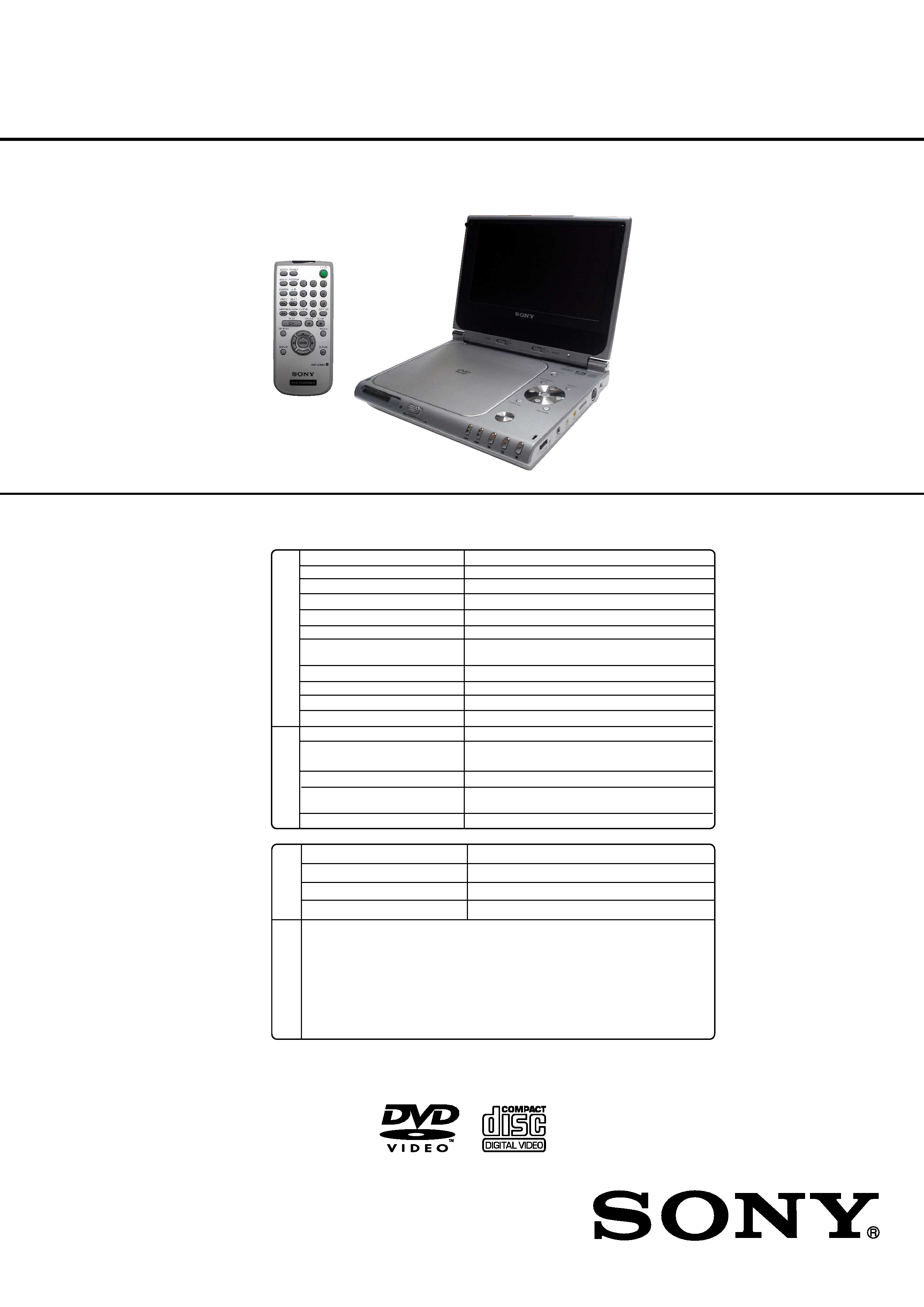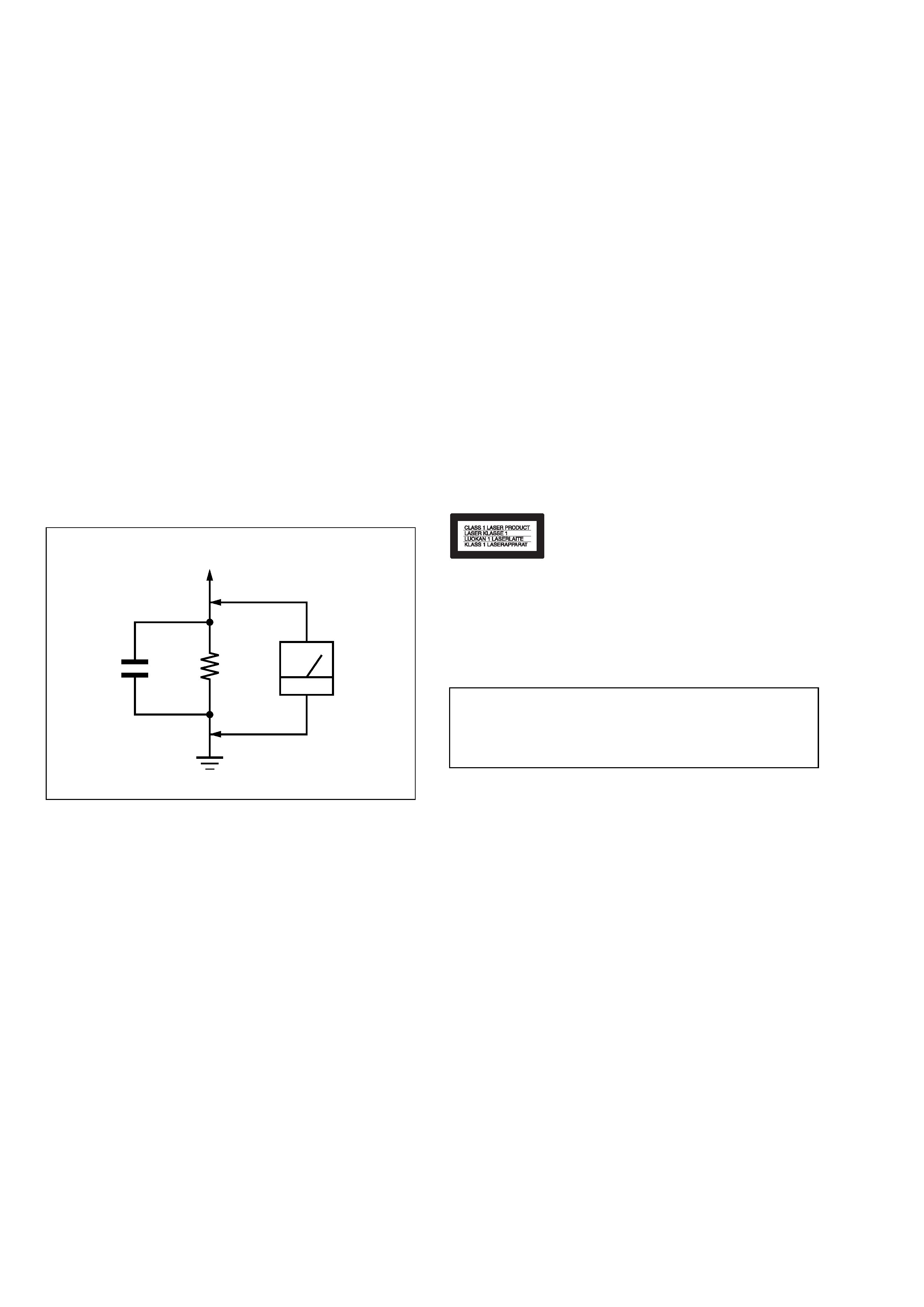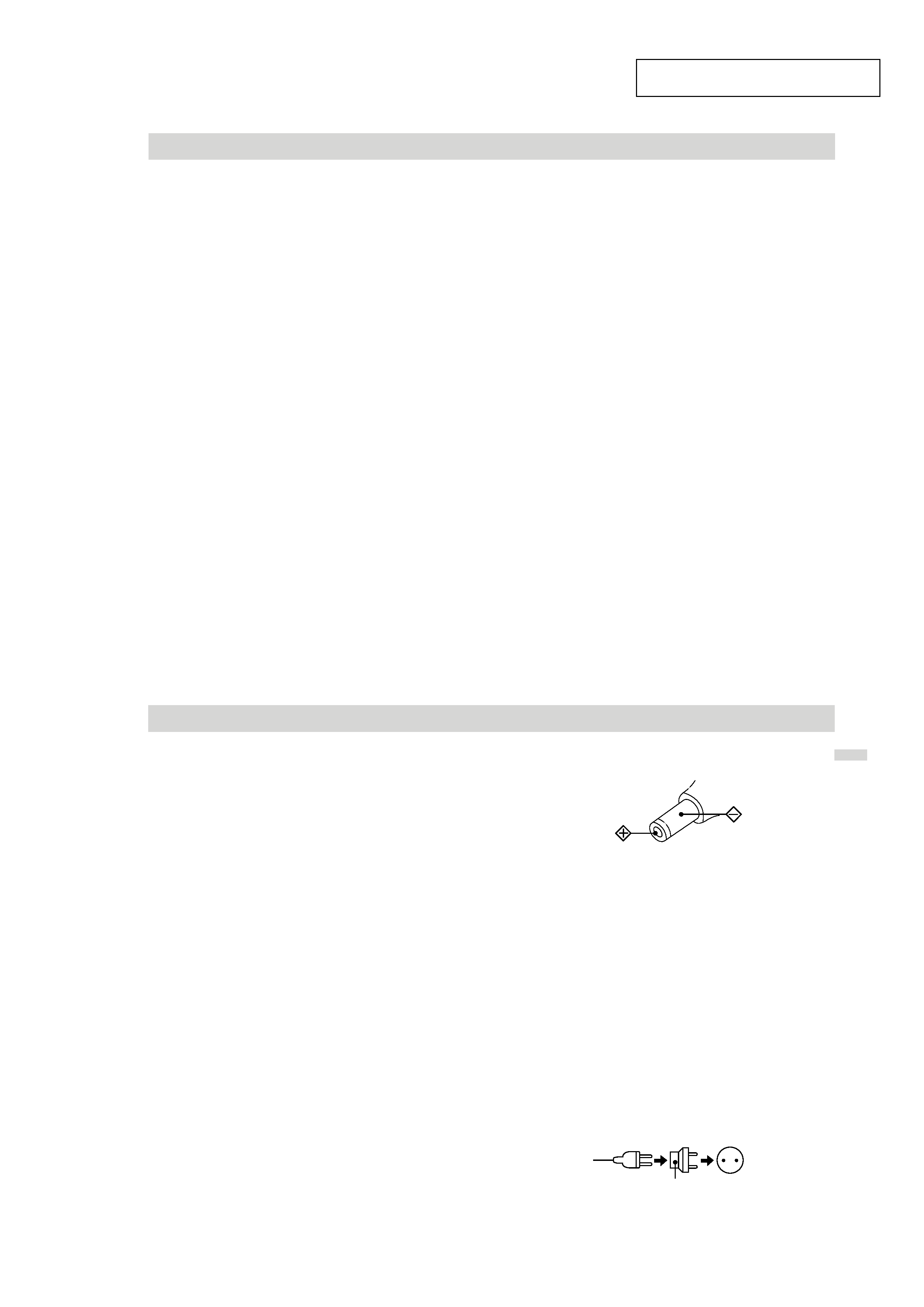
SERVICE MANUAL
Designs and specifications are subject to change without notice.
[Liquid
Crystal
Display]
[Supplied
Accessories]
Panel size
7 inches (16:9)
Projection system
TN color transmission
Driving system
a-Si TFT active matrix
Resolution
234 x 480 (effective pixel rate: more than 99.99%)
· S-Video cord ..............................................................................................1
·Audio/Video connecting cord .....................................................................1
·AC Adapter (AC-FX100) ............................................................................1
· Power Cord ................................................................................................1
· Battery Pack (NP-FX100) ..........................................................................1
· Remote control (RMT-D163A) ...................................................................1
· Size AA (R6) batteries................................................................................2
[DVD
player]
Power supply
DC 9.8 V (AC adapter terminal), DC 7.4 V (Battery)
Power consumption
12 W with battery
Weight
1.4 lbs (0.65 kg) (without battery pack)
External dimensions (W X D X H)
7.4 x 5.9 x 1.0 inches (189 x 150.3 x 26.1 mm)
Signal system
NTSC
Laser
Semiconductor laser, wavelength 650 nm (DVD), 780 nm (CD)
Frequency range (audio)
DVD linear sound:48kHz sampling 4 Hz to 20 kHz
96kHz sampling 4 Hz to 44 kHz
Signal-to-noise ratio (audio)
More than 95 dB
Dynamic range (audio)
More than 95 dB
Harmonic distortion (audio)
0.08 %
Operating conditions
Temperature: 41°F to 95°F, Operation status: Horizontal
Video input/output (VIDEO In/Out)
1.0 V (p-p), 75 , negative sync., ø3.5mm mini jack x 1
S-video output
(Y) 1.0 V (p-p), 75 , negative sync., Mini DIN 4-pin x 1
(C) 0.3 V (p-p), 75
Audio output (optical audio)
Optical connector (ø3.5mm) x 1
Audio input/output
2.0 Vrms(1 KHz, 0 dB), ø3.5mm mini jack x 1
(AUDIO In/Out, analog audio)
Earphone terminal
ø3.5mm stereo mini jack x 1
[Connectors]
US Model
Canadian Model
PORTABLE CD/DVD PLAYER
DVP-FX700
RMT-D163A
SPECIFICATIONS

2
WARNING!!
WHEN SERVICING, DO NOT APPROACH THE LASER
EXIT WITH THE EYE TOO CLOSELY. IN CASE IT IS
NECESSARY TO CONFIRM LASER BEAM EMISSION,
BE SURE TO OBSERVE FROM A DISTANCE OF
MORE THAN 25 cm FROM THE SURFACE OF THE
OBJECTIVE LENS ON THE OPTICAL PICK-UP BLOCK.
CAUTION
Use of controls or adjustments or performance of procedures
other than those specified herein may result in hazardous ra-
diation exposure.
SAFETY-RELATED COMPONENT WARNING!!
COMPONENTS IDENTIFIED BY MARK 0 OR DOTTED
LINE WITH MARK 0 ON THE SCHEMATIC DIAGRAMS
AND IN THE PARTS LIST ARE CRITICAL TO SAFE
OPERATION. REPLACE THESE COMPONENTS WITH
SONY PARTS WHOSE PART NUMBERS APPEAR AS
SHOWN IN THIS MANUAL OR IN SUPPLEMENTS PUB-
LISHED BY SONY.
Fig. A.
Using an AC voltmeter to check AC leakage.
1.5 k
0.15
µF
AC
voltmeter
(0.75 V)
To Exposed Metal
Parts on Set
Earth Ground
LEAKAGE TEST
The AC leakage from any exposed metal part to earth ground
and from all exposed metal parts to any exposed metal part having
a return to chassis, must not exceed 0.5 mA (500 microamperes).
Leakage current can be measured by any one of three methods.
1. A commercial leakage tester, such as the Simpson 229 or RCA
WT-540A. Follow the manufacturers' instructions to use these
instruments.
2. A battery-operated AC milliammeter. The Data Precision 245
digital multimeter is suitable for this job.
3. Measuring the voltage drop across a resistor by means of a
VOM or battery-operated AC voltmeter. The "limit" indica-
tion is 0.75V, so analog meters must have an accurate low-
voltage scale. The Simpson 250 and Sanwa SH-63Trd are ex-
amples of a passive VOM that is suitable. Nearly all battery
operated digital multimeters that have a 2V AC range are suit-
able. (See Fig. A)
1. Check the area of your repair for unsoldered or poorly-sol-
dered connections. Check the entire board surface for solder
splashes and bridges.
2. Check the interboard wiring to ensure that no wires are
"pinched" or contact high-wattage resistors.
3. Look for unauthorized replacement parts, particularly transis-
tors, that were installed during a previous repair. Point them
out to the customer and recommend their replacement.
4. Look for parts which, though functioning, show obvious signs
of deterioration. Point them out to the customer and recom-
mend their replacement.
5. Check the line cord for cracks and abrasion. Recommend the
replacement of any such line cord to the customer.
6. Check the B+ voltage to see it is at the values specified.
7. Check the antenna terminals, metal trim, "metallized" knobs,
screws, and all other exposed metal parts for AC leakage.
Check leakage as described below.
SAFETY CHECK-OUT
After correcting the original service problem, perform the following
safety checks before releasing the set to the customer:
CAUTION:
The use of optical instrument with this product will increase eye
hazard.
This CD/DVD player is CLASS 1 LASER PRODUCT.
ATTENTION AU COMPOSANT AYANT RAPPORT
À LA SÉCURITÉ!
LES COMPOSANTS IDENTIFIÉS PAR UNE MARQUE 0
SUR LES DIAGRAMMES SCHÉMATIQUES ET LA LISTE
DES PIÈCES SONT CRITIQUES POUR LA SÉCURITÉ
DE FONCTIONNEMENT. NE REMPLACER CES COM-
POSANTS QUE PAR DES PIÈCES SONY DONT LES
NUMÉROS SONT DONNÉS DANS CE MANUEL OU
DANS LES SUPPLÉMENTS PUBLIÉS PAR SONY.

3
TABLE OF CONTENTS
Section
Title
Page
Section
Title
Page
1.
GENERAL
Precautions ................................................................... 1-1
About This Manual ........................................................ 1-4
Notes about the Discs ................................................... 1-4
Identification of Controls ............................................... 1-4
Power Connections ....................................................... 1-7
Playing a Disc ................................................................ 1-9
General information about GUI Menu Icons ................. 1-12
Detailed Description of each GUI Menu Icon ............... 1-12
Using a Title/DVD Menu ................................................ 1-13
Changing Subtitle Language ......................................... 1-14
Changing Audio Soundtrack Language ........................ 1-14
Viewing form another Angle .......................................... 1-15
Product a 3D Surround Effect ....................................... 1-15
Repeat Play ................................................................... 1-16
Random Play ................................................................. 1-17
Program Play ................................................................. 1-17
Operation with Audio CD and MP3 disc ....................... 1-18
Operation with JPEG disc ............................................. 1-20
Selection of Initial Settings ............................................ 1-21
Selecting Disc Language .............................................. 1-21
Selecting Rating Level .................................................. 1-22
Selecting Area Code ..................................................... 1-22
Selecting TV Aspect ...................................................... 1-23
Selecting Menu Language ............................................ 1-23
Selecting Digital Audio Output ...................................... 1-24
Others ............................................................................ 1-25
Table of Languages and their Code Numbers .............. 1-25
Area Code List ............................................................... 1-26
Connecting to a TV ........................................................ 1-27
Connecting to an amplifier equipped
with a Dolby Digital decoder ......................................... 1-27
Connecting to an amplifier equipped
with a Dolby Pro Logic Surround .................................. 1-28
Connecting to an amplifier equipped
with a DTS decoder ....................................................... 1-28
Connecting to an amplifier equipped
with a digital audio input ................................................ 1-29
Disc Requirements ........................................................ 1-29
Copyright Information .................................................... 1-30
Before Calling Service Personnel ................................. 1-30
2.
DISASSEMBLY
2-1.
Cabinet Assy Removal .................................................. 2-1
2-2.
CD Lid Removal ............................................................ 2-2
2-3.
MD, MAIN Board Removal ............................................ 2-2
2-4.
LCD Panel Removal ...................................................... 2-3
3.
BLOCK DIAGRAMS
3-1.
System Block Diagram .................................................. 3-1
3-2.
Power Block ................................................................... 3-3
3-3.
Audio/Video Block ......................................................... 3-5
3-4.
TFT-LCD Block .............................................................. 3-7
4.
SCHEMATIC DIAGRAMS
4-1.
Main Power .................................................................... 4-1
4-2.
Servo ............................................................................. 4-3
4-3.
Main (MTK1379) ............................................................ 4-5
4-4.
Audio .............................................................................. 4-7
4-5.
Video .............................................................................. 4-9
4-6.
Front Main/IR ................................................................. 4-11
4-7.
LCD (Chroma) ............................................................... 4-13
4-8.
LCD (Control) ................................................................ 4-15
4-9.
LCD (DC/DC Conv.) ...................................................... 4-17
4-10. Inverter .......................................................................... 4-19
4-11. Switch ............................................................................ 4-21
5.
PRINTED WIRING BOARDS
5-1.
Circuit Boards Location ................................................. 5-1
5-2.
MAIN Board ................................................................... 5-3
5-3.
TFT-LCD Board ............................................................. 5-7
5-4.
TN-LCD/INVERTER Boards ......................................... 5-9
5-5.
SWITCH Board .............................................................. 5-11
6.
WAVEFORMS
6-1.
Details and Waveforms on System Test
and Debugging .............................................................. 6-1
6-2.
Circuit Voltage Chart ..................................................... 6-11
6-3.
LCD Voltage Sheet ........................................................ 6-13
7.
IC PIN FUNCTION DESCRIPTION
7-1.
System Control Pin Function
(MAIN Board IC500: MT1379) ...................................... 7-1
8.
ELECTRICAL ADJUSTMENT
8-1.
LCD Adjustment ............................................................ 8-1
8-1-1. How to adjust LCD COLOR ..................................... 8-1
9.
TROUBLESHOOTING
9-1.
Electrical Trouble Shooting Guide ................................. 9-1
1.
Power (DC-DC Converter) Circuit ................................. 9-1
2.
MPEG Circuit ................................................................. 9-4
3.
Front Circuit (Dogotrpm & Key) ..................................... 9-5
4.
RF/Servo Circuit ............................................................ 9-6
9-2.
LCD Trouble Shooting Guide (1/2) ................................ 9-9
9-3.
LCD Trouble Shooting Guide (2/2) ................................ 9-10
10.
REPAIR PARTS LIST
10-1. Exploded Views ............................................................. 10-1
10-1-1. LCD Panel Section ................................................... 10-1
10-1-2. Upper Case Section ................................................. 10-2
10-1-3. Bottom Case Section ............................................... 10-3
10-2. Electrical Parts List ....................................................... 10-4

1-1
SECTION 1
GENERAL
This section is extracted from instruc-
tion manual (3-088-314-11).
DVP-FX700
Precautions
4
For customers in the U.S.A
Owner's Record
The model and serial numbers are located on the bottom of the unit. Record the serial number in the space provided
below. Refer to them whenever you call upon your Sony dealer regarding this product.
Model No. DVP-FX700
Serial No.______________
For Customers in Canada
If this product is not working properly, please call 1-877-602-2008 for
Peace of Mind Warranty Replacement service.
For other product related questions please contact our Customer
Information Service Centre at 1-877-899-7669 or write to us at: Customer Information Service 115 Gordon Baker Road,
Toronto, Ontario, M2H 3R6
CAUTION
You are cautioned that any change or modifications not expressly approved in this manual could void your authority to
operate this equipment.
NOTE
This equipment has been tested and found to comply with the limits for a Class B digital device, pursuant to Part 15 of the
FCC Rules. These limits are designed to provide reasonable protection against harmful interference in a residential installa-
tion. This equipment generates, uses, and can radiate radio frequency energy and, if not installed and used in accordance
with the instructions, may cause harmful interference to radio communications. However, there is no guarantee that interfer-
ence will not occur in a particular installation. If this equipment does cause harmful interference to radio or television recep-
tion, which can be determined by turning the equipment off and on, the user is encouraged to try to correct the interference
by one or more of the following measures:
Reorient or relocate the receiving antenna.
Increase the separation between the equipment and receiver.
Connect the equipment into an outlet on a circuit different from that to which the receiver is connected.
Consult the dealer or an experienced radio/TV technician for help.
Introductions
5
Precautions (continued)
· The power requirements and power consumption of this
are indicated on the AC power adaptor. Check that the
unit's operating voltage is identical with your total power
supply.
On safety
· Caution The use of optical instruments with this product
will increase eye hazard.
· To prevent fire or shock hazard, do not place objects filled
with liquids, such as vases, on the apparatus.
· Should any solid object or liquid fall into the cabinet,
unplug the player and have it checked by qualified per-
sonnel before operating it any further.
· Do not put any foreign objects in the DC IN 9.8V (external
power input) jack.
On temperature increases
· Heat may build up while charging or during extented use.
This is not a malfunction.
· If the surrounding temperature is very high the protective
function will turn off the player automatically.
Leave the player cool location for about 30 minutes
before using it again.
· Use only the supplied AC power adaptor. Do not use any
other AC power adaptor. It may cause a malfunction.
· If the AC power adaptor causes interference to radio
reception, move it away from the radio.
· Do not touch the AC power adaptor with wet hands.
· The player is not disconnected from the AC power source
(mains) as long as it is connected to the wall outlet, even
if the player itself has been turned off.
· If you are not going to use the player for a long time, be
sure to disconnect the player from the wall outlet. To dis-
connect the AC power cord (mains lead), grasp the plug
itself; never pull the cord.
· Should the AC power cord need to be changed, have it
done at a qualified service shop only.
· Use a commercially available AC plug adaptor, if neces-
sary, depending on the design of the wall outlet.
Polarity of the plug
Wall outlet
AC plug adaptor
AC-FX100

1-2
6
Precautions (continued)
On the rechargeable battery
· Charge the rechargeable battery before you start using it.
· Do not allow dust to come into contact with the battery
terminals of the player and rechargeable battery.
· Do not short the terminals.
· Do not open the terminal covers of the player.
· Keep the battery dry.
· Use only the rechargeable battery(NP-FX100) supplied
with this player(DVP-FX700). Other rechargeable batter-
ies supplied with other models cannot be used with this
player.
· Do not disassemble.
· Do not incinerate.
· Dispose of use battery promptly.
To dispose of the rechargeable battery
· Certain countries may regulate disposal of the battery
used to power this product. Please consult with your local
authority.
To store the rechargeable battery
The rechargeable battery is consumed gradually as time
elapses even if is not used. In order to prevent the battery
from deteriorating, store the rechargeable battery as fol-
lows:
· Remove the rechargeable battery from the player after
use.
· Use up the battery completely on the player before stor-
ing it.
· Keep the rechargeable battery in a cool location to pre-
vent it from deteriorating.
· Charge and use the rechargeable battery at least once in
6 months.
On charging the rechargeable battery
· Heat may build up the rechargeable battery while
charging. This is not a malfunction.
· When the battery life of a fully charged rechargeable bat-
tery becomes about half the normal life, you may need to
replace the battery with a new one.
· Disconnect the rechargeable battery from the player as
soon as the battery has been charged. Leaving it con-
nected may result in reduced battery performance.
Introductions
7
Precautions (continued)
On handing the player
· Keep the lens on the player clean and do not touch it. If
you do so, the lens may be damaged and the player will
not operate properly.
· Place the player in a location with adequate ventilation to
prevent heat build-up in the player.
· Do not put any heavy object on top of the player. The
player and the discs may be damaged.
· Do not leave the player in a location near heat sources, or
in a place subject to direct sunlight, excessive dust or
sand, moisture, rain, mechanical shock, on an unlevel
surface, or in a car with its windows closed.
· Do not wrap the player in a cloth or blanket during use as
it may cause malfunction or serious accidents.
· If the player causes interface to radio or television recep-
tion, turn off the player or move it away from the radio or
television.
· Keep the player and discs away from equipment with
strong magnets, such as microwave ovens, or lager loud-
speakers.
· If the player is brought directly from a cold to warm loca-
tion, or is placed in a very damp place, moisture may con-
dense on the lenses of the player. Should this occur, the
player may not operate properly. In this case, remove the
disc and leave the player for about half an hour until the
moisture evaporates.
· Discs with non-standard shapes (e.g, heart, square, star)
cannot be player on this player. Do not use discs.
· While operating, do not move,shake or otherwise allow
any shock to the player. It may cause a malfunction.
· Use this player in a stable, horizontal position where it is
not subject to vibration.
· Do not touch the disc if it is still spinning when you open
the lid.
· When you move the player, take out any, you don't, the
disc may be damaged.
It's too
warm!
